Probably the most popular excursion outside of the city of San Cristóbal de las Casas is a visit to the Tzotzil Maya villages of San Juan Chamula and San Lorenzo Zinacantán . There are several alternatives but the best known and a well-reviewed tour is organized by Alex y Raúl Tours. 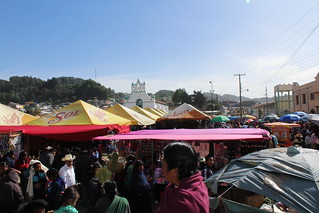 That tour is available 7 days a week from 9:30 am to 2:00 at a cost is $200 pesos per person, which includes transportation, entrance fees and an English speaking guide. The meeting point is the cross located in the front of the Cathedral in San Cristóbal.
That tour is available 7 days a week from 9:30 am to 2:00 at a cost is $200 pesos per person, which includes transportation, entrance fees and an English speaking guide. The meeting point is the cross located in the front of the Cathedral in San Cristóbal.
We considered taking the Alex and Raul Tour but we had also wanted to incorporate a visit to San Andrés Larráinzar on the day we visited Chamula and Zinacantán so we headed out on a Sunday morning with Guide Juan José Cruz. Our first stop was the Tzotzil Maya village of San Juan Chamula. Sunday is a good day for visiting Chamula for a couple reasons. First, it is market day and this is a very large and active market. In addition to produce and household items, one of the common products for sale in the market was wool in many forms; all for use in the making of the textiles of the village. 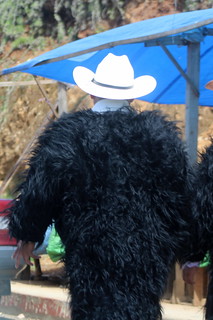
The most obvious characteristic of the dress of the people of Chamula is the heavy long haired black wool skirts worn by women and the men sometimes wearing a full suit worn and other times just a tunic with shorts. The women usually wear the shaggy hair apparel all the time while most men typically only don the traditional garments for special events, of which Sunday is considered.
As we walked through the market we came to a courtyard just above the market with long benches on 3 sides 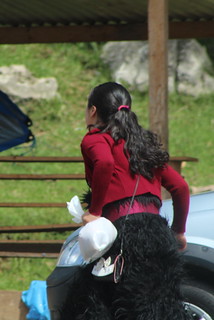 of the space. There were 10-12 men on 2 of the benches and the 3rd had a few local residents siting. Most of the men wore a black wool tunic and a very distinctive hat with wide multicolored ribbons flowing over the brim. Those were the city officials and they were not only observing the market but were available for consultation with the local citizens who might have a municipal request or a grievance to air.
of the space. There were 10-12 men on 2 of the benches and the 3rd had a few local residents siting. Most of the men wore a black wool tunic and a very distinctive hat with wide multicolored ribbons flowing over the brim. Those were the city officials and they were not only observing the market but were available for consultation with the local citizens who might have a municipal request or a grievance to air.
Sitting with them were city police wearing a white versions of the same heavy attire and cowboy hats.I wish we had more photos to show the scene but the people of Chamula are well known for preferring not to have their picture taken by tourists. We heard multiple stories of tourist having the memory card from their camera removed and/or erased or even of cameras being confiscated for violating this privacy. We attempted to respect that desire so despite the urge, we didn’t take v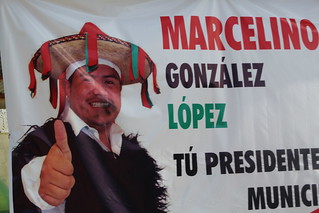 ery many pictures of the people in Chamula and the few that we took were of their backs and from a moving car.
ery many pictures of the people in Chamula and the few that we took were of their backs and from a moving car.
As it turned out, we were there a few days prior to local elections and this photo of a billboard for mayoral candidate does show him in his official “uniform”.
We asked Juan José why the people of Chumula would wear such heavy hot long-haired garments and he told us it stemmed from a part of the Dominican’s plan for converting the indigenous people of the region to Catholicism. In addition to allowing the merging of traditional Maya symbols with Catholic icons in the church (as discussed on our Tenejapa page), the Dominican’s also introduced sheep, an animal that had never been seen in Chiapas to the local community and told the Mayans that it was a gift from the Catholic God. The people of Chamula adopted the long wooly dress to honor this gift. Included in this honoring is that the sheep are not eaten but only used for their wool.
Earlier in this discussion we mentioned that there were a couple good reasons for 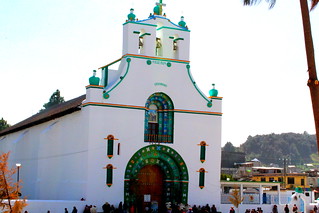 visiting on a Sunday. The second reason is the chance to observe a service of the very unique religion practiced in Chamula.
visiting on a Sunday. The second reason is the chance to observe a service of the very unique religion practiced in Chamula.
The day we visited was graduation day at the local school and there was a packed house inside the small church celebrating the event. No pictures of the service are allowed but the air was heavy with incense and there were pine needles spread over parts of the floor and candles not only on tables along the side of the building but also set up in patterns on the floor; often times with a bottle of Coca Cola that we were told was serving the role of a “sacrifice”. Chickens are also often used but not on the day we were there. 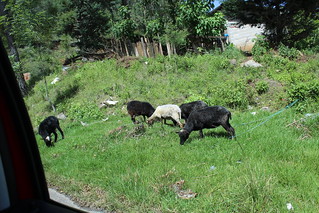 The service was being led in Spanish by a Catholic priest but he shared the front of the church with a mariachi band.
The service was being led in Spanish by a Catholic priest but he shared the front of the church with a mariachi band.
Afters we left the market area we stopped at a small store on our way out of town and while we were there, a procession of local citizens led by a brass band paraded by. That was where we were able to take the only shots of the local dress shown above. As we passed the outscrirts of the city, we passed several grazing sacred sheep.
Next stop, the Tzotzil-speaking village of San Andrés Larráinzar; a town with one of the strongest weaving traditions in Chiapas.
